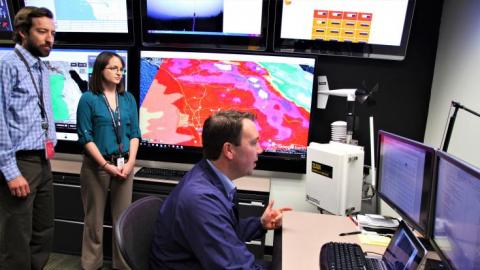From wildfire threats to fierce winds and heavy rainstorms, weather can have the greatest impact on energy operations. At SDG&E, our goal is to deliver the cleanest, safest and most reliable energy to our customers, which means making sure we have access to the best weather data to reduce threats, increase situational awareness and improve public safety.
In 2009, we employed our first staff meteorologist to begin building out a weather network. Less than a decade later, SDG&E is home to a team of dedicated meteorologists and the largest private utility network in the world.
Three’s company
When SDG&E’s first meteorologist Brian D’Agostino came on board in 2009, collecting weather data looked a bit different than it does today. Using a circuit-by-circuit approach to fire preparedness, D’Agostino would drive to the windiest circuits throughout the service territory looking for the right spot to place a weather station that would give the best information.
“We were on a mission to make a positive impact on the entire region in terms of reducing the threat of wildfires,” says D’Agostino. “Integrating weather science, big data and situational awareness into the operation of the power grid gives us a big head start in wildfire preparedness.”
In a course of two years, SDG&E installed 130 weather stations in fire-prone areas. Managing all of the weather data and round-the-clock forecasts required more manpower, leading the company to bring on a second meteorologist, Steve Vanderburg. From chasing storms and tornadoes in Oklahoma to managing the fire program at the local National Weather Service, Vanderburg brings over a decade of experience as a weather expert.
“You can only learn so much from a textbook,” Vanderburg says. “Chasing storms and tornadoes gave me an opportunity to experience the life cycle of weather events and interpret all the textbook data into the real world.”
In 2013, SDG&E’s weather expert “trifecta” was completed with the addition of Katie Giannecchini, who brings to the team a passion for the weather—calling herself a weather dork—and a Master’s degree in Atmospheric Sciences.
“I’ve known I wanted to be a meteorologist since I was 10-year-old huddled under a tree as the rain poured from the sky,” says Giannecchini. “Weather has always fascinated me and I knew exactly what I wanted to do once I realized I could make a career out of it.”
Giannecchini admits meteorology is a male-dominated field, but has been met with nothing but support since joining SDG&E’s meteorology team.
Largest utility weather network in the world
Today, SDG&E’s network consists of 170 individual weather stations that provide real-time information at critical locations across the region—including hurricane-force wind gusts that were recorded in parts of the backcountry. Understanding the strength of the winds is useful to our engineers as they undergo work to enhance our electric infrastructure and strengthen our system.
Information like wind speeds, humidity and temperatures is used to inform operational decisions and create better situational awareness making us more prepared than ever for emergencies in the future. We also share this data with the National Weather Service and local firefighters and other emergency responders so they have better information to safely do their jobs and help us build more resilient communities.
SDG&E has leveraged the network and created tools to integrate weather forecasts, fuel moisture content and humidity levels to create a wildfire threat Index which rates the potential for wildfires fueled by strong seasonal winds.
Similar to hurricane-strength categories, the rating system helps the public, first responders and energy company crews plan their response based on the severity of the threat. For example, we may stage crews in a certain area in advance of severe weather so that we’re ready to quickly respond to changing conditions that could threaten public safety. Additionally, each rating comes with a recommended action to help the community better prepare for the potential of catastrophic wildfires based on the rating scale.
New Weather Awareness System
Our team of meteorologists also collaborates with universities and weather experts to evaluate the impacts of climate change and improve climate resiliency in order to protect critical infrastructure in wildfire-prone Southern California. In fact, our new Weather Awareness System utilizes SDG&E’s very own weather station network to predict and identify potential risks to the service territory through situational awareness. This system incorporates weather information from the Santa Ana Wildfire Threat Index, mountaintop cameras, National Weather Service and more.
Our goal is to continue taking steps to reduce the risk of wildfires throughout our region and support public safety awareness programs to help educate and protect our customers, employees and community.
Click here to learn more about our fire safety and emergency preparedness efforts.
Editor’s note: this is part of SDG&E’s #10WeeksOfSummer campaign where customers can learn more about how we power San Diego and get tips & tools to help you save money and energy.


